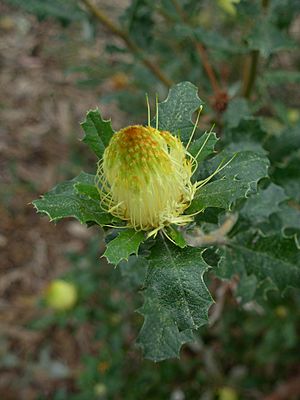Urchin dryandra facts for kids
Quick facts for kids Urchin dryandra |
|
|---|---|
 |
|
| Scientific classification | |
| Genus: |
Banksia
|
| Species: |
undata
|
| Synonyms | |
|
|
The Urchin Dryandra, also known as Banksia undata, is a special kind of shrub. It only grows in the southwest part of Western Australia. This plant has unique leaves that are wedge-shaped and wavy, with jagged edges. Its flowers are pale yellow and grow in clusters of 80 to 160 flowers. After flowering, it produces up to eight seed pods, called follicles, in each cluster.
Contents
What Does Urchin Dryandra Look Like?
Urchin dryandra is a shrub that usually grows up to 3 m (9.8 ft) tall. It does not have a special woody base called a lignotuber that helps some plants regrow after fire.
Its leaves are wedge-shaped and wavy, with jagged edges. They are 25–110 mm (0.98–4.33 in) long and 10–60 mm (0.39–2.36 in) wide. The leaves attach directly to the stem without a stalk, or with a very short one. Each side of a leaf has between four and nine uneven teeth.
The flowers are pale yellow and grow in round clusters. Each cluster has between 80 and 160 flowers. At the base of each flower cluster are hairy, egg-shaped to narrow, pointed leaves called bracts, which are 12–15 mm (0.47–0.59 in) long. The flower parts (perianth) are 30–38 mm (1.2–1.5 in) long and sometimes look a little pink. The female part of the flower (pistil) is 31–52 mm (1.2–2.0 in) long.
Urchin dryandra flowers from July to October. After the flowers fade, up to eight egg-shaped to oval seed pods, called follicles, form in each cluster. These pods are 12–15 mm (0.47–0.59 in) long.
How Did Urchin Dryandra Get Its Name?
This plant was first officially described in 1848 by a Swiss botanist named Carl Meissner. He named it Dryandra praemorsa. He published its description in a book called Plantae Preissianae. The plants he studied were collected by James Drummond near the Swan River in Western Australia.
Later, in 1996, another botanist named Alex George described two different types, or varieties, of D. praemorsa. These varieties had slightly different leaf and pistil sizes.
In 2007, two scientists, Austin Mast and Kevin Thiele, moved all the plants from the Dryandra group into the Banksia group. This meant Dryandra praemorsa needed a new name because there was already a plant called Banksia praemorsa.
Mast and Thiele chose "undata" for the new name. This comes from the Latin word undatus, which means "wavy." This name refers to the wavy edges of the plant's leaves. The two varieties are now called Banksia undata var. splendens and Banksia undata var. undata.
Where Does Urchin Dryandra Grow?
Urchin dryandra is found in a specific area of Western Australia. It grows between the towns of Clackline, Dwellingup, and Bannister. It prefers to grow in forests where Jarrah trees are common.
The variety splendens grows from the Brookton Highway south to Bannister. The variety undata is found between Clackline and Dwellingup.
What About Its Future?
Scientists have studied how climate change might affect this plant. They found that the area where urchin dryandra can grow might shrink a lot by the year 2080. It could lose between 50% and 80% of its current habitat, depending on how much the climate changes.
Is Urchin Dryandra Endangered?
The Western Australian Government's Department of Parks and Wildlife has looked at the conservation status of Banksia undata and its two varieties. They have classified them as "not threatened." This means they are not currently considered to be in danger of disappearing.

